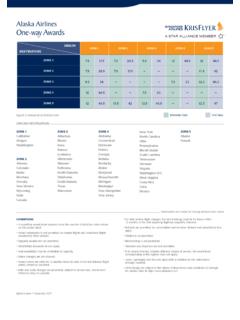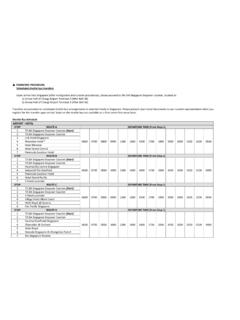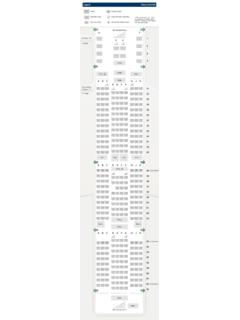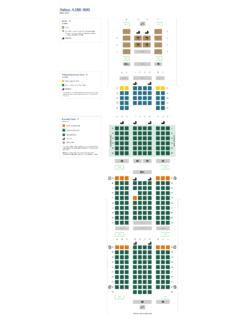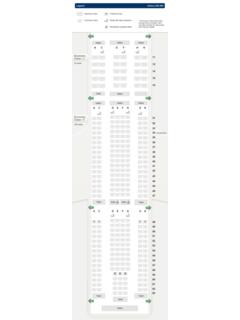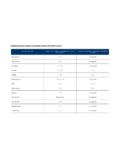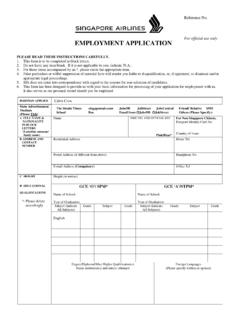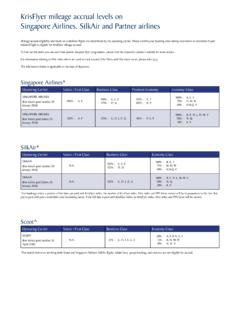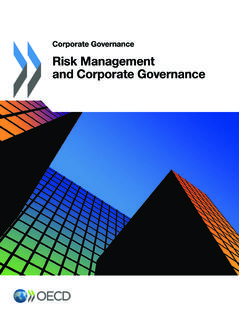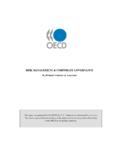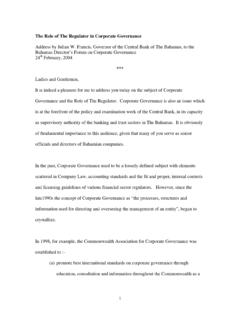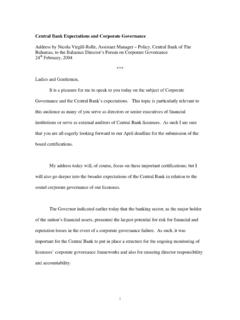Transcription of 1 RISK MANAGEMENT FRAMEWORK 2 GOVERNANCE & …
1 SIA S RISK MANAGEMENT FRAMEWORK 1 RISK MANAGEMENT FRAMEWORK In 2002, SIA formalised its Risk MANAGEMENT FRAMEWORK , encompassing a GOVERNANCE & Reporting Structure, a standardised Risk MANAGEMENT Process and a set of risk MANAGEMENT Principles, Policies and Guidelines. 2 GOVERNANCE & REPORTING STRUCTURE Board of Directors - Annually, SIA s Board of Directors reviews and discusses the strategic and other key risks of the Group. Board Committees - The Board s oversight is supported by the Board Safety & Risk Committee (made up of independent Board Directors) and other Board Committees that review and ensure that specific top risks are managed appropriately.
2 The Board Safety & Risk Committee oversees MANAGEMENT s implementation of the Risk MANAGEMENT FRAMEWORK and assesses the effectiveness thereof annually. SIA Group Risk Reporting Structure BOARD OF DIRECTORS Board Safety & Risk Committee SINGAPORE AIRLINES Risk & Compliance MANAGEMENT Committee Risk MANAGEMENT Committee SIA CARGO Risk MANAGEMENT Committee SIAEC GROUP Risk MANAGEMENT Committee Risk MANAGEMENT Committee SIA Group Risk & Compliance MANAGEMENT Committee BUDGET AVIATION HOLDINGS Risk MANAGEMENT Committee Risk MANAGEMENT Committee Other Subsidiary Companies Risk MANAGEMENT Committee or equivalent SILKAIR Risk & Compliance MANAGEMENT Committee Risk MANAGEMENT Committee Risk MANAGEMENT Committees - The Group Risk & Compliance MANAGEMENT Committee
3 And various Company Risk MANAGEMENT Committees drive the implementation of the Risk MANAGEMENT FRAMEWORK , and through detailed review of specific risks and corresponding risk controls, ensure that risks are identified and managed, and surfaced for the Board Committees attention. Risk MANAGEMENT Function - A dedicated Risk MANAGEMENT Department provides support to the Risk Committees and to business units, ensuring that risks are surfaced by business units from the bottom-up to complement the top-down perspectives provided by top MANAGEMENT and the Risk Committees. risks are structured under 5 main categories Strategic & Reputation, Financial, Regulatory/Compliance, Human Resource/Industrial Relations and Operational/ Environmental & Others for ease of communication and coordination.
4 3 RISK MANAGEMENT PROCESS Structured Process - Within the Risk MANAGEMENT FRAMEWORK , a simplified 5-step Risk MANAGEMENT Process is adopted to allow easier communication, understanding and application by all levels of staff. The 5-steps to Identify, Evaluate, Prioritise, Reduce and Review risks form a re-iterative flow of activities depicted as follows: Multi-pronged Strategies - Within this process, multi-pronged Risk Reduction strategies such as Risk Prevention, Risk Mitigation and Risk Transfer are employed to address the risks . Wherever possible, preventive measures are adopted and complemented with Crisis MANAGEMENT , Business Continuity and Disaster Recovery plans that are coordinated and integrated into a seamless risk response effort.
5 Risk policies, guidelines and tolerance limits are incorporated into the process to ensure adequacy and effectiveness of risk responses. SIA s 5-Step Risk MANAGEMENT Process Embedded Activity - Twice each year, all business units carry out a Group-wide risk review to ensure that risk registers are kept current and risk controls are improved and up-to-date. These processes are embedded within the work schedules of the business units, and driven by the quarterly risk review activities of the Risk Committees. 4 PRINCIPLES, POLICIES AND GUIDELINES Governing Philosophy - The overarching philosophy is provided by the Risk MANAGEMENT Policy Statement as follows:- SIA is to be a risk-aware organisation such that the taking of risks necessary for the achievement of its corporate objectives is carried out knowingly, and risks that represent a threat to SIA are managed so as to protect and enhance the value of the organisation in the interests of shareholders and stakeholders of SIA.
6 Principles - A set of Risk MANAGEMENT Principles adapted from ISO 31000 provide the underlying basis for the scope and objectives of the risk MANAGEMENT effort. Risk MANAGEMENT should: (a) create and protect value by facilitating continual improvement of the organisation. (b) be an integral part of all organisational processes, including decision-making. (c) reduce the probability or consequences of the risk event. (d) be systematic, structured and timely. (e) be based on the best available information and reviewed regularly. (f) be customised to the needs of the organisation, including taking into account human, cultural and environmental factors.
7 (g) be transparent and inclusive. (h) be dynamic, iterative and responsive to change. Corporate Risk Objectives - A set of corporate risk objectives guides business units in formulating plans to manage risks . These objectives can be represented by the mnemonic PEARLS and are: People - to protect People from harm or injury Environment - to protect the Environment from damage and pollution Assets - to protect the Assets of the company Reputation - to protect the Reputation of the company Liability - to protect against incurring Liability Supply-chain - to protect the Supply-chain against critical disruptions Controls and Limits - Written guidelines on managing specific types of risks provide the control boundaries and performance standards for business units to comply with in managing risks .
8 All risk responses are required to be tested where practicable, to ensure that they are adequate to the risks identified, and effective in reducing the risks to within tolerance limits or better.
